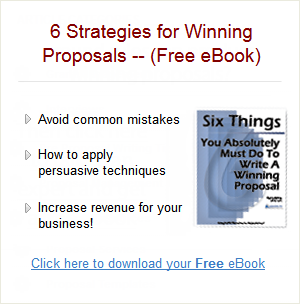Help Your Readers: Get Rid of the Fog in Proposals
We all know unclear writing when we see it. Long sentences, lots of big words. Technical writing is filled with it. So are proposals, especially those written by technical experts.
Contrary to prevailing opinions that “engineers can’t write,” my experience tells me that engineers—and other technically-oriented folks—write very well. Their sentences are often extremely elegant constructions. The problem is that much of what they write is not appropriate to proposals. A sentence may be elegant, but if it is hard to read—if the reader has to work too hard to make sense of it—then it won’t be read.
How do you tell if a passage is going to be hard for a reader to digest in one pass? One way is to determine the “fog factor.” You can do this easily by using one of the tools on your word processor—the grammar checker.
On either of the two most prevalent word processors-MS Word and WordPerfect-you can adjust the settings on your grammar checker to give you a report on the reading level of a selected passage. This statistic can be a very helpful way to gauge the readability of your writing.
This reading level is based on school grade. If you get a reading level of 11, that simply means that a reader with an 11th grade reading ability should be able to get through—and understand—the passage on one pass. Newspapers shoot for a reading level of 6. You should be aiming at a reading level of 10.
What the checker checks for. The grammar checker assess two key factors in a given passage: the length of the sentences and the number of polysyllabic words—words of three syllables or more. The longer the sentences and the more polysyllabic words in a passage, the higher the reading level. And the more difficult it is to read.
Passing your proposal sections through the grammar checker will give you immediate feedback. If the number you get back is, say, 15 (a college junior), then you know you either have longer sentences of more difficult words (probably both) than you need to get a reading level of 10.
What’s so magical about a reading level of 10? The short answer is, nothing. On the other hand, if you’re writing to a college educated reader, a reading grade level of 10 makes it very easy for him to get to your main point. When your daily paper aims for a 6th grade reading level it is simply making it easier for the reader to get through the articles; it doesn’t mean that the articles are directed toward 6th graders.
Shooting for a 10th grade reading level simply means that you should shorten the sentences, and select simpler words. This just makes good sense anyway. Remember, the evaluator is looking for any excuse to quit reading your proposal. Don’t give it to him by making him wade through a thick fog to get at your meaning.
Some Rules of Thumb. Here are a few quick tips for keeping your fog factor low:
- Try for an average sentence length of 15 words. Some will be shorter, some longer, and you’ll want to vary them.
- Use simple words in place of the more “impressive” big words (“Use” vs. “utilize,” for example). This will cut down on the multi-syllable words that increase the fog factor.
- Use active voice; passive voice adds more words, which increases fog.

